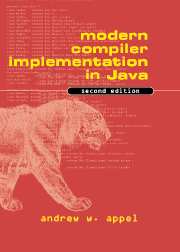Book contents
- Frontmatter
- Contents
- Preface
- Part I Fundamentals of Compilation
- Part II Advanced Topics
- 13 Garbage Collection
- 14 Object-Oriented Languages
- 15 Functional Programming Languages
- 16 Polymorphic Types
- 17 Dataflow Analysis
- 18 Loop Optimizations
- 19 Static Single-Assignment Form
- 20 Pipelining and Scheduling
- 21 The Memory Hierarchy
- Appendix: MiniJava Language Reference Manual
- Bibliography
- Index
15 - Functional Programming Languages
from Part II - Advanced Topics
Published online by Cambridge University Press: 05 June 2012
- Frontmatter
- Contents
- Preface
- Part I Fundamentals of Compilation
- Part II Advanced Topics
- 13 Garbage Collection
- 14 Object-Oriented Languages
- 15 Functional Programming Languages
- 16 Polymorphic Types
- 17 Dataflow Analysis
- 18 Loop Optimizations
- 19 Static Single-Assignment Form
- 20 Pipelining and Scheduling
- 21 The Memory Hierarchy
- Appendix: MiniJava Language Reference Manual
- Bibliography
- Index
Summary
func-tion: a mathematical correspondence that assigns exactly one element of one set to each element of the same or another set
Webster's DictionaryThe mathematical notion of function is that if f(x) = a “this time,” then f(x) = a “next time”; there is no other value equal to f(x). This allows the use of equational reasoning familiar from algebra: If a = f(x), then g(f(x), f(x)) is equivalent to g(a, a). Pure functional programming languages encourage a kind of programming in which equational reasoning works, as it does in mathematics.
Imperative programming languages have similar syntax: a → f(x). But if we follow this by b → f(x), there is no guarantee that a = b; the function f can have side effects on global variables that make it return a different value each time. Furthermore, a program might assign into variable x between calls to f(x), so f(x) really means a different thing each time.
Higher-order functions. Functional programming languages also allow functions to be passed as arguments to other functions, or returned as results. Functions that take functional arguments are called higher-order functions.
Higher-order functions become particularly interesting if the language also supports nested functions with lexical scope (also called block structure). Lexical scope means that each function can refer to variables and parameters of any function in which it is nested. A higher-order functional language is one with nested scope and higher-order functions.
- Type
- Chapter
- Information
- Modern Compiler Implementation in Java , pp. 298 - 334Publisher: Cambridge University PressPrint publication year: 2002



